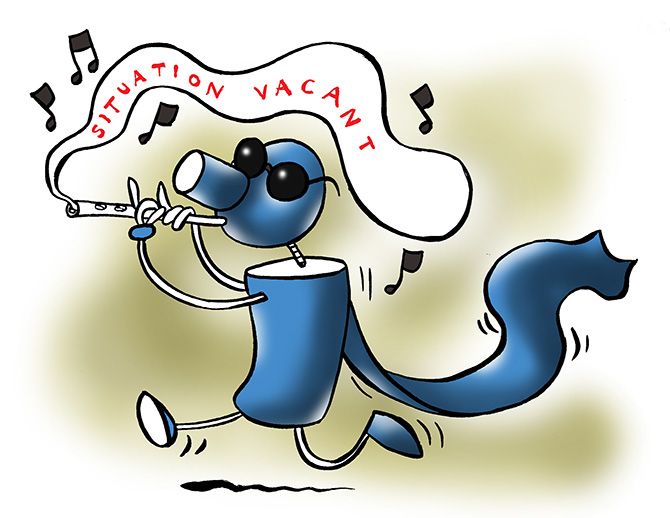 | « Back to article | Print this article |
As of the week ended July 2017, the unemployment rate was 3.1 per cent. This is the lowest unemployment rate recorded.
Rural unemployment was also very low at 2.8 per cent.
Mahesh Vyas's insight.

Illustration: Uttam Ghosh/Rediff.com
The index of consumer sentiments improved during the week ended July 30. It rose by 0.9 per cent. Both constituents, the current economic conditions and consumer expectations, improved.
The improvement reflects buoyancy in the rural sector. The rural index of consumer sentiments improved by 1.5 per cent.
This is significant improvement compared to the declining trend in rural sentiments seen since mid-June.
Rural sentiments have moved in response to the progress, albeit somewhat uncertain, of the southwest monsoon. Kharif sowing data suggest that farmers are cautiously optimistic.
Area sown under kharif crops was 3.3 per cent higher this year till July-end compared to the progress in sowing in the corresponding period last year. Most of the increase comes from an increase in the area under cotton, sugarcane, bajra and urad. The major disappointments are soyabean and arhar. Cotton and sugarcane are cash crops. These are likely to help the farm sector gain substantially.
The southwest monsoon was aggressive during the week ended July 26. Overall precipitation during the week was 22 per cent higher than the norm.
But the spatial distribution was very highly skewed. Gujarat region received rains that were 271 per cent higher than the norm. It suffered a double whammy as excessive rains of west Rajasthan (a massive 267 per cent higher than the norm) also flooded the state.
The probability of rains being in such excess during a week is less than 5 per cent.
Such excessive rains have caused some damage to standing crops in Gujarat. About 25 to 30 per cent of the cotton areas in Gujarat has been damaged by excessive rains. The loss in groundnut could be 15-17 per cent.
Rains were similarly excessive in neighbouring states of Gangetic West Bengal (+293 per cent) and Jharkhand (+262 per cent).
The southern peninsula, which has been deficient in rains this year, continued to receive very little rains.
Damages caused by such excessive rains are not uncommon every season. The benefits of a heavy downpour often outweigh the losses they sometimes cause.
The poor temporal and spatial distribution of rainfall notwithstanding, the overall precipitation seems to have raised the spirits of the rural gentry somewhat by the end of July.
The rural index of consumer sentiments, however, continues to remain lower than its level before the monsoon season set in. During the week ending May 28, the index was at 107.3. By the end of the week ending July 30 it was 100.
***
When a boy wrote to Modi seeking euthanasia for his unemployed father, family
***
Urban consumer sentiments in July are turning out to be better than they were in the preceding months.
The urban consumer sentiments index is likely to be a shade above 97 during July. This would be substantially higher than its level in the preceding six months.
While consumer sentiments have improved during July, labour markets are still weak.
Labour participation has been falling. It fell from over 48 per cent in early 2016 to 44 per cent by April 2017. Since then, the ratio had stabilised at just below 44 per cent. However, during the week ended July 30, the labour participation rate (LPR) fell to 43.5 per cent.
This specific fall may not mean much because weekly estimates do bounce a bit. It is possible that the LPR will bounce back in the coming weeks. But what is worrying is the continued weakness in the ratio. This is its third consecutive weekly fall.
Further, save for one unusual fall to 42.6 per cent a few weeks ago, the latest fall in the LPR to 43.5 per cent is to its lowest level.
The LPR had started improving in urban areas from June. For six weeks, it remained above 41 per cent, giving indications that the fall witnessed in the ratio till May had been arrested. The last week of July was a disappointment as the ratio fell to 40.7 per cent.
Similar weakness was seen in the rural LPR in the last two weeks of July. The low LPR continues to help keep the unemployment artificially low.
As of the week ended July 2017, the unemployment rate was 3.1 per cent. This is the lowest unemployment rate recorded.
Urban unemployment rate at 3.6 per cent was close to its lowest rate of 3.3 per cent recorded in the first week of July. Rural unemployment was also very low at 2.8 per cent.
The author is managing director and CEO, Centre for Monitoring Indian Economy P Ltd.
Recommended for you